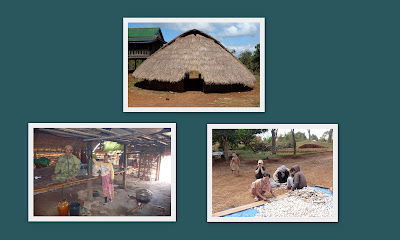
Mondulkiri was once a part of Chhlong Leu district in Kratie Province. In 1960, it was separated by King Norodom Sihanouk into the new province. Mondulkiri Province is located in the northeast part of Cambodia. It is bordered to the north by Stung Trèng and Rattanakiri, to the east and to the south by Vietnam, and to the west by Kratie. Mondulkiri is a hilly and sparsely populated province. It occupies a total area of 14,288 sq. km and has a population of 60,811 which include 14 races; Khmer 20% and ethnic minorities 80%. These ethnic groups are composed of Phnorng, Stieng, Kuoy, Tompuon, Charay, Kraol, Kroeng, Ra Ong, Thmon, Cham, Chinese, Vietnamese, and Lao. The Khmer people are public servants and merchants, and remnants of them are all farmers. The Mondulkiri province, at an average elevation of 800m above the sea level, has different climates compared to the other parts of Cambodia. It may get warm in daytime, and it turns chilly at night-time. The Mondulkiri province is divided into five districts, Sen Monorom, Kèv Seima, Koh Nhèk, O Reang, and Péch Chenda; and 21 communes, Nang Khi Loek, Or Bun Leu, Roya, Sok San, Srè Huy, Srè Sangkom, Dak Dam, Sen Monorom, Krang Teh, Bouchri, Srè Ampum, Bousra, Monorom, Sokh Dom, Spean Meanchey, Romonea, Chong Phlas, Mé Mang, Srè Chhouk, Srè Khtom, and Srè Preah. Sen Monorom was established the provincial town of Mondulkiri in 1962. There is a quaint small community nestling between lush hills and two small lakes. The area around Sen Monorom has plenty of ethnic minorities’ villages. Along the road of Sen Monorom, tourists can see many Phnorng people from nearby villages come to Sen Monorom to trade, and they can view the distinctive baskets the ethnic groups carry on their backs to make them easily distinguish from the Khmer immigrants at market. Sen Monorom can get quite cool in the evening, especially in the early dry season so it is recommended that you should bring an extra layer of clothes for night-time. The Mondulkiri province is enormously rich in various natural resources to be explored, such as majestic mountains, rainforest, indigenous wildlife, pine plantation, impressive waterfalls, small rivers, waterfront parks, etc. It is now the intended eco-tourism destination for the eco-tourists and the adventurous travelers. They can travel and discover the wildlife in the remote parts of the province, trek up hills/ mountains, ride on elephants, visit the Bou sra waterfall and other waterfalls, and learn about the daily life of the ethnic minorities. They can also savor the famous local wine called “Sra Peang”.




